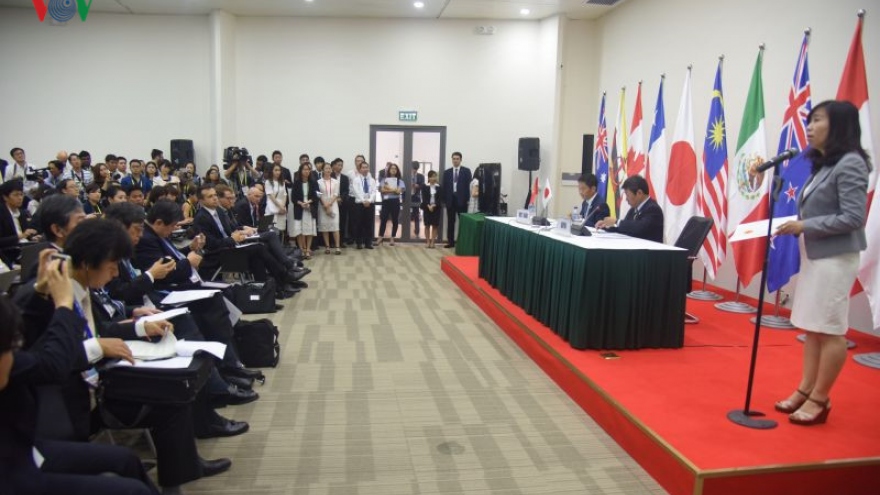12 becomes 11, and the TPP finds a way forward
With the US withdrawal from the Trans-Pacific Partnership, the remaining 11 nations have decided to develop the pact into another version named the Comprehensive and Progressive Agreement for Trans-Pacific Partnership.
 |
Raymond Mallon, senior economic advisor from the Australia-Vietnam economic reform programme, delves into this new pact, which can have some impact on Vietnam’s economy.
Changes address concern about impact on national sovereignty and equity
At the Danang APEC meetings, the remaining TPP-11 (CPTPP) members reaffirmed their commitment “to open markets, to combat protectionism, and to advance regional economic integration.” While the cumbersome new name may not last, the new agreement should provide long-term benefits for all remaining TPP members, including Vietnam.
The Danang statement promotes the TPP “principles and high standards as a way to promote regional economic integration and contribute to the economic growth prospects of its member countries, and create new opportunities for workers, families, farmers, businesses and consumers.”
The statement appears to recognize the need to address concerns in TPP communities that elements of the TPP agenda were dominated by politically connected business interest groups. Changes also address earlier concerns that TPP could impinge on the rights of sovereign governments to address national concerns such as inequality, health and environment issues and climate change.
The controversial provisions on investor state dispute resolution are likely to be relaxed to make it be more difficult for investors to sue member states for the costs incurred investors because of national public interest regulations (for example related to health or environmental safeguards). Investors will only be able to sue a government for alleged breached of specific obligations identified in the TPP Investment Chapter.
This means that Vietnamese government will retain greater flexibility to regulate in the national public interest.
Some attempts to extend intellectual protection have been suspended, including those relating to extending durations of patent protection, restricting attempts to circumvent the protection of digital information, and “procedural fairness” provisions that were to be applied to the pharmaceutical industry.
Four relatively minor key areas where further negotiations are required to achieve consensus before finalising the TPP are: state enterprises (Malaysia), services and investment non-conforming measures, (Brunei), dispute settlement, trade sanctions (Vietnam), and cultural exception (Canada).
Reduced global impact of TPP
Obviously, the US withdrawal from TPP will reduce the global impact of the agreement. The TPP-11 member countries account for only about one-third of the total GDP, and 60% of the population, of TPP-12.
However, economic modelling confirms net benefits for all remaining member countries. While the US withdrawal from TPP will adversely impact on its citizens, the US’ North American neighbours, Mexico and Canada, should gain additional benefits, as potential US trade is diverted to Mexico and Canada, Peru and Chile are also expected to experience greater benefits following the US withdrawal.
Impact of TPP changes on Vietnam
Recent modelling suggests that TPP-11 would generate an increase of 2.43% in exports among partner countries (about 40% of what would have occurred under TPP12).
Earlier economic modelling showed that Vietnam was the country with the most to gain from TPP-12. Most of the net gains would have resulted from potential increases in trade (especially garments and footwear) with the US. While still potential beneficiaries of TPP-11, Vietnam (and Japan), are likely to experience the largest reductions in potential gains, because they stood to gain the most in the US market under TPP-12. The US withdrawal will eliminate many of the large gains that Vietnam stood to make in textiles and apparel in the US market under TPP-12. Despite this loss, Vietnam is still expected to be a significant beneficiary from TPP-11 in terms of the per cent impact on GDP growth.
Once implements, TPP-11 member countries will only need to comply with one consistent set of rules of sourcing and producing goods and services from all other member countries. For example, a Japanese company that produces goods with inputs from Vietnam and Malaysia could sell to the Australian market using TPP-11 preferential arrangements since all the countries are members of TPP-11. A company sourcing imported inputs from a non-TPP-11 country could not access full TPP preferences. No longer a TPP member, the US will be excluded from the supply chain benefits of the agreement.
Streamlining of the rules of origin are likely to be particularly beneficial for small and medium-sized enterprises (SMEs), who often lack the capacity needed to understand and comply with the differing requirements of multiple markets. The other changes to commitments are not likely to have a substantive direct economic impact on Vietnam, but will reduce risk of private investors taking costly legal action against Vietnam public interest regulations. Importantly for Vietnam, there are no change to the goods market access outcomes contained in the original TPP.
Potential benefits of moving beyond TPP-11
Vietnam should still consider unilaterally adopting economic reforms that go beyond TPP commitments, where such reforms are beneficial to Vietnam regardless of any trade and investment concessions from other countries.
Reform to reduce poverty gaps between women and men has the potential to boost productivity growth. Equalising retirement ages and removing remaining regulatory constraints that restrict the opportunity of women to move to higher productivity employment should be immediate priorities.
Reforming regulations to facilitate the development of competitive factor markets will be critical for both efficiency and equity objectives. Reforms to markets for agriculture land use rights are needed to ensure that farmers can benefit equitably from their agriculture land use rights. Reforms that help to simplify procedures and reduce the administrative costs of doing business are particularly important for SMEs that often lack the resources needed to overcome bureaucratic hurdles.
Extending competition policy reforms beyond TPP commitments could help drive the innovation and creativity needed for Vietnam to accelerate productivity growth and to develop a vibrant service sector. The adoption and implementation of a national competition policy framework that clearly specifies good regulatory principles that have to be followed by all government agencies could help.
Reforms to national regulators to make them independent of agencies that exercise ownership rights or represents particular business groups, would increase al-locative efficiency, stimulate productivity growth and promote more equitable outcomes. An immediate priority would be to ensure that the Vietnam Competition Authority operates independently in implementing the new Competition Law.
The TPP-11 agreement has the potential to benefit Vietnam and those investing in Vietnam, but other domestic reforms could be taken to generate even greater national economic benefits.


